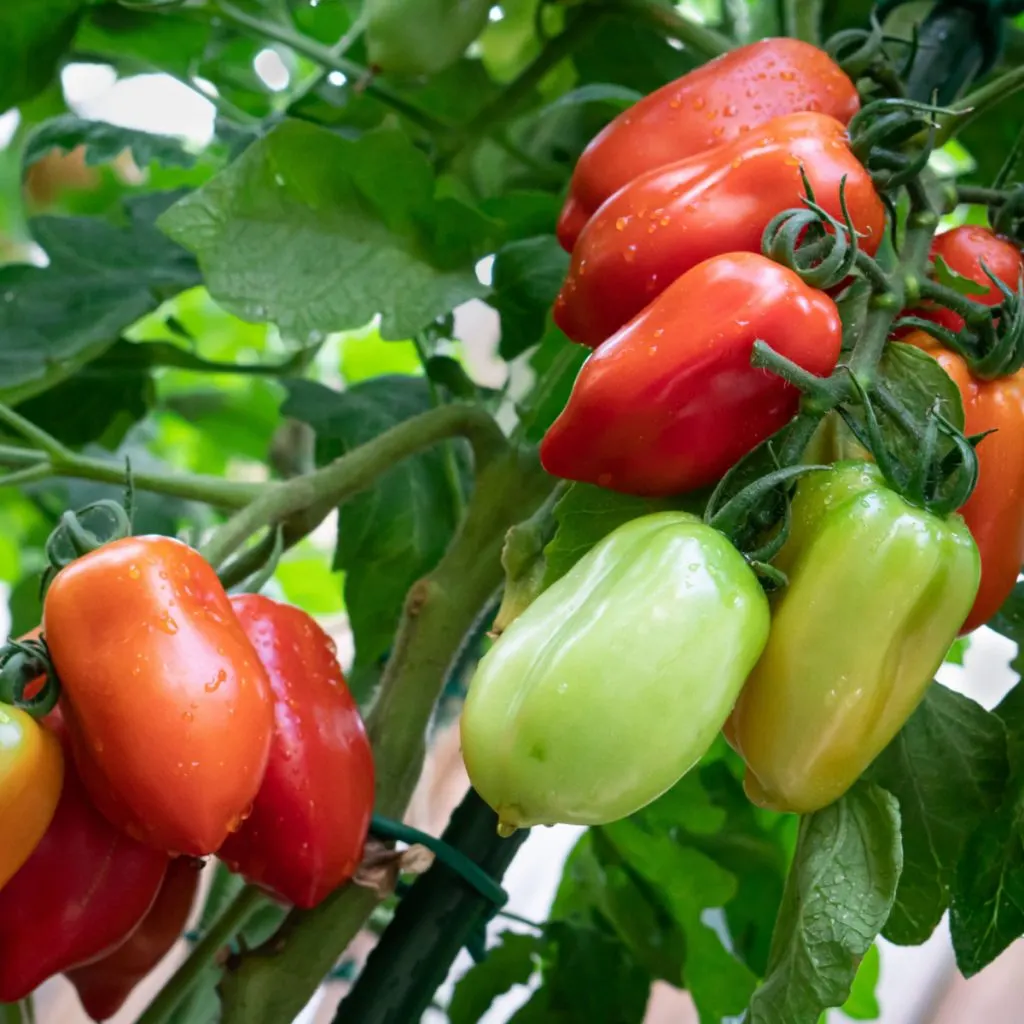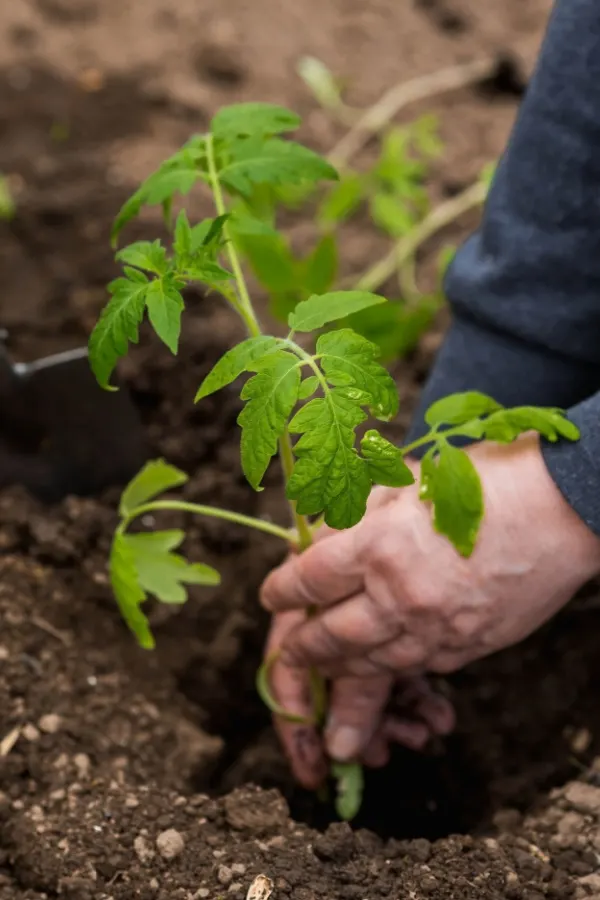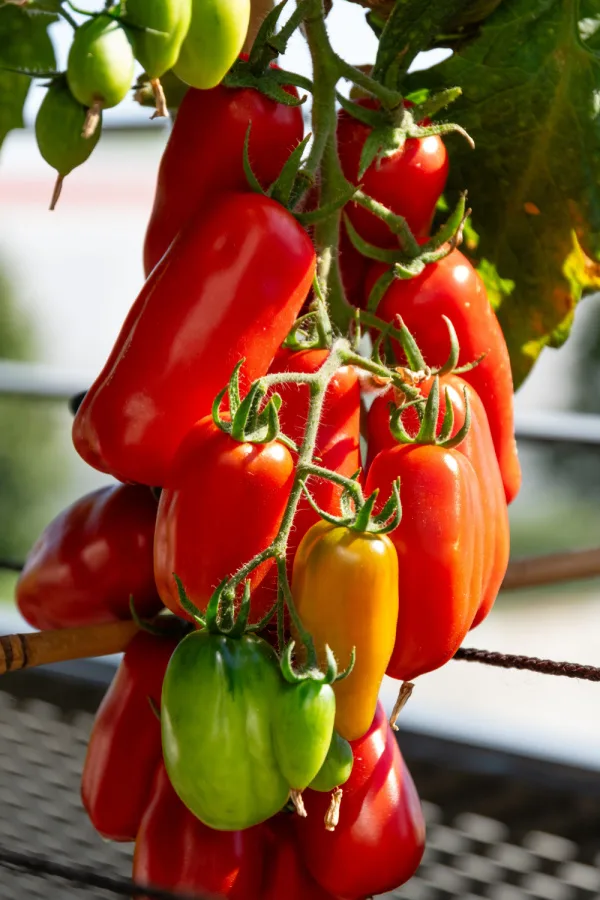Why should you be growing San Marzano tomatoes in your garden, raised beds or containers? Because it’s the one single tomato variety you can grow almost anywhere that can give you an amazing harvest of tomatoes that are perfect for almost any need!
Not all tomato varieties are created equal, and that is definitely the case when it comes to the San Marzano. As a paste tomato, it’s certainly great for turning into deliciously rich and flavorful sauces, salsas and purees – but as you will see below – it can be incredible for all of your fresh eating needs too!
Not only do San Marzano plants produce loads of perfectly-sized paste tomatoes, but their flavor and juice content are on point. In addition, while they still taste sweet, their acidic level and consistency are just right for safe canning and preserving.

San Marzano tomatoes were first grown in the area surrounding Naples, Italy in the Campania region. The tomato variety’s popularity began to explode in the area in the 1800s when it became famous for making one of the best pizza sauces around.
It wasn’t long after, the tomato began to find its way to other regions as people discovered that because of its amazing flavor and qualities, not only was the tomato perfect for making pizza and pasta sauce – it could be used for almost anything!
What Makes San Marzano Tomatoes The Perfect Tomato
There is little doubt the tomato’s flavor is one of its best attributes. San Marzano tomatoes have a sweet profile with a rich, concentrated flavor. Yet they still have enough acid to be canned and stored safely.
Unlike some tomatoes, San Marzano tomatoes have a meaty interior with very few seeds and little liquid. Their low water content allows them to quickly be turned into thick pasta and pizza sauces. And those same qualities make them great for making salsa too.
San Marzano tomatoes are longer and overall a bit larger than most paste tomato varieties. They also have thin skins, which makes them much easier to peel – a task that can be time consuming when it comes to turning your tomatoes into amazing culinary dishes.

In addition, their dense interior holds up well to high-heat cooking and processing. That makes them ideal for canning salsa or diced tomatoes – as the tomatoes stay more firm through and after the process.
If all of that wasn’t enough, San Marzano tomatoes are prolific growers and producers. The plant produces large harvests of larger 4+ ounce size fruit – and does so all season long. San Marzano plants are indeterminate, which means they will continue to produce fresh tomatoes all growing season long, right up until the first frost.
Last but not least, the plants are more compact than other indeterminate tomato varieties. That means you can grow them successfully in a traditional garden, or in smaller spaces such as raised beds or even containers. And as you will see below – they also happen to be easy to grow and maintain!
How To Grow San Marzano Tomatoes
Using Seeds Or Transplants
San Marzano tomatoes are relatively simple to plant and grow. As long as you meet their basic needs, they will reward you with an endless supply of fresh paste tomatoes.
You can often find San Marzano transplants in local nurseries and greenhouses starting in early Spring. Choose plants that have thick, sturdy stems with healthy leaves. However, you can also easily start them from seed indoors. Seeds are easy to find, but make sure you are purchasing the San Marzano heirloom variety. Affiliate Product link: San Marzano Heirloom Tomato Seeds
When growing your own, start tomato seeds indoors about 8 weeks before your last frost date. This will give your seedlings plenty of time to grow large enough for easy transplanting.

Planting San Marzano Tomatoes
Whether you purchase tomato transplants or start them indoors, wait until the outside temperature is consistently around 50º Fahrenheit (F) before moving the tomatoes outside for hardening off. Hardening off transplants is important as it prepares them for full time outdoor life. See: How To Harden Off Plants – Why Hardening Off Is A Must For Young Transplants!
San Marzano plants require at least 6 to 8 hours of direct sunlight each day, so choose a spot with plenty of sunlight. The more the better! A lack of sunlight will affect how many blooms and fruit the plants can produce.
Once the outside daytime temperatures are consistently above 60º F and the soil is above 60º F, you can safely plant San Marzano tomatoes. Use a soil thermometer to ensure that the soil is nice and warm to give your plants the best chance to establish quickly. (Affiliate Product Link: 3 in 1 Soil Tester)
When planting, create a 6 to 8-inch deep planting hole with plenty of compost, egg shells, worm castings, and coffee grounds mixed in. Along with well-draining soil, these additions provide plants with a good source of nutrients and resources to get off to a great start.

Plant the San Marzano deeply in the soil. Bury several inches of the main stem as well as the roots. Even though plants don’t grow to be huge, having a sturdy base of roots will help secure the plant to the soil when it is loaded full of ripening fruit. In addition, more roots allow plants to draw up loads of much-needed nutrients from the soil.
Maintaining Your Tomato Plants – Growing San Marzano Tomatoes
Even though they only grow to heights of around 4 to 6 feet, San Marzano plants will need support in the way of a stake or cage.
San Marzano tomatoes tend to be bushy plants that carry a lot of fruit. This can eventually weigh down stems, causing them to break. Supports help keep plants up off the ground and improve air circulation – reducing the risk of soil-borne disease and more.
It’s best to add supports to plants right after transplanting to avoid damaging roots later on. In addition, also add several inches of organic mulch around each San Marzano plant. A four inch layer of grass clippings, straw, or shredded leaves will work well to reduce weeds, regulate soil temperature and conserve moisture.
Post Planting Care – Growing San Marzano Tomatoes
San Marzano plants need to be watered weekly with around 1 to 1.5 inches of rainwater or watering by hand. Water plants a few times a week deeply at the base if rain is not supplying the necessary moisture.

All tomato plants are heavy feeders. That means nutrients in the soil need to be replenished frequently throughout the growing season.
Fertilize plants every 2 weeks with compost tea or every 3 to 4 weeks with a commercial organic liquid fertilizer. Stop fertilizing as mid summer arrives (after about 4 applications) so plants can focus on fruit production.
Because San Marzano plants are indeterminate tomatoes, they will benefit from occasional pruning. Remove the bottom 12 inches of stems as they mature. This helps to increase airflow and keep plants off of the ground. It’s also a good idea to remove suckers to help keep plants from growing too unruly.
Pick Often…
To keep San Marzano tomatoes in heavy production all growing season long you need to harvest frequently. When plants get overwhelmed with fruit, they will start to slow overall production. To prevent this, pick fruit as soon as they have slightly started to turn red.
The fruit will continue to ripen off the vine and will allow the plant to concentrate energy on producing more in place of ripening existing fruit. Here is to growing San Marzano tomatoes and turning them into delicious sauces, salsas, purees and more!
Follow Our Facebook Page For Even More Great Tips! Simple Garden Life Facebook Page
Simple Garden Life is a website dedicated to keeping gardening fun, simple and enjoyable! We publish two new articles each week along with a new garden podcast episode every two weeks. This article may contain affiliate links.
